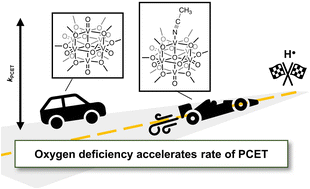Accelerated rates of proton coupled electron transfer to oxygen deficient polyoxovanadate–alkoxide clusters†
Abstract
Anionic dopants, such as O-atom vacancies, alter the thermochemical and kinetic parameters of proton coupled electron transfer (PCET) at metal oxide surfaces; understanding their impact(s) is essential for informed material design for efficient energy conversion processes. To circumvent challenges associated with studying extended solids, we employ polyoxovanadate–alkoxide clusters as atomically precise models of reducible metal oxide surfaces. In this work, we examine net hydrogen atom (H-atom) uptake to an oxygen deficient vanadium oxide assembly, [V6O6(MeCN)(OCH3)12]0. Addition of two H-atom equivalents to [V6O6(MeCN)(OCH3)12]0 results in formation of [V6O5(MeCN)(OH2)(OCH3)12]0. Assessment of the bond dissociation free energy of the O–H bonds of the resultant aquo moiety reveals that the presence of an O-atom defect weakens the O–H bond strength. Despite a decreased thermodynamic driving force for the reduction of [V6O6(MeCN)(OCH3)12]0, kinetic investigations show the rate of H-atom uptake at the cluster surface is ∼100× faster than its oxidized congener, [V6O7(OCH3)12]0. Electron density derived from the O-atom vacancy is shown to play an important role in influencing H-atom uptake at the cluster surface, lowering activation barriers for H-atom transfer.

- This article is part of the themed collections: Inorganic Chemistry Frontiers Emerging Investigator Series 2022–2023 and FOCUS: Metal and Metal-Containing Clusters


 Please wait while we load your content...
Please wait while we load your content...